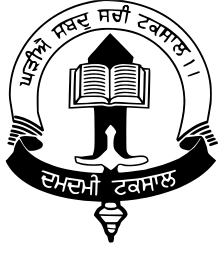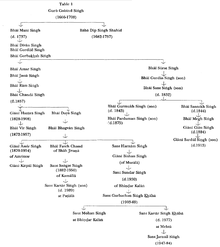Damdami Taksal
The Damdami Taksal is a Sikh educational organisation in India.[1] Its headquarters are located in the town of Mehta Chowk, approximately 25 miles north of the city of Amritsar.[2] It has been described as a seminary or “moving university” of the Sikh countryside.[3]

In 1706, after the Battle of Muktsar, Guru Gobind Singh camped at Sabo Ki Talwandi. The place became known as Damdama i.e. a halting place (or breathing place), this place is now referred to as Damdama Sahib[4] (In 1737, Damdama Sahib was considered to be the highest seat of learning for the Sikhs).[5] Damdami Taksal claims to be over 300 years old with direct historical ties to Guru Gobind Singh and Baba Deep Singh.[6][3]
History

The line of leaders of the Sikh religious institution Damdami Taksal The word taksal (literally 'mint') refers to an education institute or community of students who associate themselves to a particular sant or prominent spiritual leader.[8] "In 1706..... Gobind Singh...... is said to have founded a distinguished school of exegesis".[9] It was later headed up by Baba Deep Singh[10] According to the Damdami Taksal, it was entrusted with the responsibility of teaching the reading (santhyia), analysis (vichar) and recitation of the Sikh scriptures by Guru Gobind Singh.
The main center of the present-day Damdami Taksal (Jatha Bhindran-Mehta) is located at Gurdwara Gurdarshan Parkash at Mehta in Amritsar district.[11] It is actually a branch of a major school of traditional Sikh learning known as the Bhindran Taksal. Although that Taksal was established by Sant Sundar Singh (1883-1930) of Boparai Kalan (in Ludhiana district) in 1906, it achieved prominence through its second incumbent, Sant Gurbachan Singh Khalsa (1902-1969) of Bhindran Kalan (hence the name ‘Bhindran Taksal’).[11] He devoted his entire life to teaching correct enunciation and intonation in reciting the Sikh scriptures. He trained a large number of “gianis” (traditional Sikh scholars) through his mobile seminary. When he died in 1969 he was succeeded by two contenders, Giani Mohan Singh (1919-) and Sant Kartar Singh (1932-1977), the former leading the original Malwa branch in Ludhiana district and the latter leading the Majha branch in Amritsar district.[11]
During the first part of the 20th century Gurbachan Singh Bhindranwale was a widely prominent Sant teaching a large number of students[12] and today remains an influential figure. The influence of Bhindran Taksal is attested by the fact that its alumni include the head granthi (reader of Sikh scriptures) at the Golden Temple, jathedars of various Sikh takhts, and granthis of major gurdwaras of historical significance.[11]
The Damdami Taksal also had a history of dispute with the Indian government, as its former head Kartar Singh Khalsa Bhindranwale was a severe critic of the excesses of Indira Gandhi’s Emergency rule.[3][2] In 1975, a large event to commemorate the 300th anniversary martyrdom of Guru Tegh Bahadur was attended by Indira Gandhi and Kartar Singh Bhindranwale. This was the starting point of tensions between Damdami Taksal and the Indian Congress Government.[13] The dispute[note 1] was about who was the leader and who had the greater authority over the Sikh people, the Guru Granth Sahib or Indira Gandhi.[14]
The Damdami Taksal was brought to wider attention by Jarnail Singh Bhindranwale and the 1978 massacre,[15] the Anandpur Resolution with the Dharm Yudh Morcha of 1982,[16] and later the Khalistan movement.[17]
Leadership
During British Colonial rule, Sunder Singh Bhindranwale[note 2] set about purging diversity in Sikh doctrine, ritual and practice, hoping to have a uniform Sikh community. Part of this strategy was to have a standardised code of conduct (Rehat Maryada).[18] Sant Kartar Singh established Gurdwara Gurdarshan Parkash at Mehta, Amritsar district.[11]
Sant Sunder Singh was succeeded by Sant Gurbachan Singh Bhindranwale in 1930, after whom Sant Kartar Singh Bhindranwale continued his work in 1961. In 1977, after the death of Sant Kartar Singh, Jarnail Singh Bhindranwale became the head of Damdami Taksal.[11][19] Baba Thakur Singh Bhinderwale[20] took over his Taksal when Jarnail Singh was killed in 1984 by the military assault on Harmander Sahib, referred to as Operation Bluestar.[21] After the death of Baba Thakur Singh, the leadership of Taksal was handed over to Baba Harnam Singh Khalsa Bhindranwale by the senior leadership and members of Taksal.[22]
Beliefs
The Damdami Taksal have their own Sikh Code of Conduct, the Gurmat Rehat Maryada, which differs from the Rehat Maryada published by the Shiromani Gurdwara Prabandhak Committee.[23] Some differences include the reading of Ragmala after Akhand Path[24] and not eating meat, fish, and eggs.[25] Damdami Taksal is somewhat influenced by the Nirmale school of thought as the eleventh leader of Damdami Taksal, Sant Baba Bishan Singh Muralewale, studied under Nirmale Sants such as Pundit Tara Singh and Pundit Sadhu Singh during the late 19th century.[26][27]
Notes
- When Indira Gandhi came onto the stage in the presence of Guru Granth Sahib, while all those on the stage arose to welcome and respect her, but it was only Kartar Singh Bhindranwale remained seated.[14] On the stage Kartar Singh spoke saying no one is more powerful than our Guru and we are not required to get up and pay respect to her, he was applauded by the people.[13]
- Sunder Singh was from the Bhindran village[8] and thus was referred to as Bhindranwale, "the one from Bhindran"
References
- "Baba Thakur Singh of Damdami Taksal dead". Retrieved 26 December 2019.
- Mahmood 1997, p. Page 75
- C. K. Mahmood (1996). Why Sikhs Fight (Anthropological Contributions to Conflict Resolution). The University of Georgia Press. p. 17. ISBN 9780820317656.
- Dhillon, Dalbir (1988). Sikhism Origin and Development. Atlantic Publishers & Distri. p. 152.
- Kapoor, Sukhbir (2003). Dasam Granth An Introductory Study. Hemkunt Press. p. 12. ISBN 81-7010-325-8.
- "Damdami Taksaal - The official website of the Damdami Taksaal". Damdami Taksaal. Retrieved 26 December 2019.
- Singh, Tāran (1995). Siṅgh, Harbans (ed.). Giānī Sampradāi (3rd ed.). Patiala, Punjab, India: Punjab University, Patiala, 2011. p. 77. ISBN 9788173805301. Retrieved 22 February 2020.
- Schomer, Karine (1987). The Sants: Studies in a Devotional Tradition of India. Motilal Banarsidass. p. 262. ISBN 9788120802773.
- Harjot Oberoi (1996). "Sikh Fundamentalism: Translating History into Theory". In Martin E. Marty; R. Scott Appleby (eds.). Fundamentalisms and the state: remaking polities, economies, and militance. The Fundamentalism Project. 3. University of Chicago Press. pp. 266. ISBN 978-0-226-50884-9.
In 1706, when Gobind Singh...he is said to have founded a distinguished school of exegesis.
- H. S. Singha (2000). The Encyclopedia of Sikhism. Hemkunt Press. p. 57. ISBN 9788170103011.
- Singh, Pashaura, Michael Hawley (2012). Re-imagining South Asian Religions: Essays in Honour of Professors Harold G. Coward and Ronald W. Neufeldt. BRILL. p. 38. ISBN 9789004242371.
- Singh, Pashaura (2003). The Guru Granth Sahib: Canon, Meaning and Authority. Oxford University Press. ISBN 9780199087730.
- Pande, B. N. (1989). Indira Gandhi: Builders of modern India. Publications Division, Ministry of Information and Broadcasting, Govt. of India.
- Judge, Paramjit (2005). Religion, Identity, and Nationhood: The Sikh Militant Movement. Rawat Publications. ISBN 9788170339496.
- Tambiah, Stanley (1997). Leveling Crowds: Ethnonationalist Conflicts and Collective Violence in South Asia. California: University of California Press. p. 106. ISBN 0520200020.
- Singh, Harjinder (2008). Game of Love (Second ed.). Walsall: Akaal Publishers. p. 61.
- Singh Tatla, Darshan (1999). "6 Demand for Homeland - Sikhs in Britain" (PDF). The Sikh Diaspora: The Search For Statehood. England: UCL Press. pp. 116 onwards. ISBN 1-85728-301-5.
- Marty, Martin (1996). Fundamentalisms and the State: Remaking Polities, Economies, and Militance, Volume 3. University of Chicago Press. p. 267. ISBN 9780226508849.
- Low intensity conflicts in India By Vivek Chadha, United Service Institution of India page 196.
- Singh, Gurharpal (2006). Sikhs in Britain: The Making of a Community. Zed Books. p. 92. ISBN 9781842777176.
- Tully, Mark (1991). The defeat of a congressman: and other parables of modern India. Knopf. p. 154. ISBN 9780394573991.
- "Damdami Taksal". Retrieved 5 March 2020.
- "Gurmat Rehat Maryada". Damdamitaksaal.org. Retrieved 9 August 2009.
- Singh, Harjinder; Singh, Sukha; Singh, Jaskeerth (2015). Sikh Code of Conduct (4th ed.). 2014: Akaal Publishers. p. 82. ISBN 978-0-9554587-4-3.CS1 maint: location (link)
- Poy, Buddy (2011). Vegetarianism Unmasked. AuthorHouse. p. 83. ISBN 9781463408756.
- Damdami Taksal De Mahapurkh. Amritsar: Damdami Taksal (Jatha Bhindran). p. 22.
- Dilgira, Harjindar (1997). The Sikh Reference Book. Sikh Educational Trust for Sikh University Centre. p. 318. ISBN 9780969596424.
Further reading
- Giani Jaswant singh Manji Sahib Book ~ Chita Chola